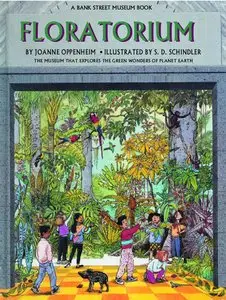Joanne Oppenheim, "Floratorium" (A Bank Street Museum Book)
Publisher: Bantam Books | 1994 | ISBN: 0553093657/0553371452 | English | True PDF | 49 pages | 8.74 Mb
Publisher: Bantam Books | 1994 | ISBN: 0553093657/0553371452 | English | True PDF | 49 pages | 8.74 Mb
Youngsters visit tropical rain forests, rolling prairies, flowering deserts, and the Arctic tundra and return with an understanding of life in those habitats and a full-color poster as a souvenir.
The fourth and final title in the Bank Street Museum series is Floratorium. Each title is laid out like a museum tour. This one is about plants & Botany. The table of contents is laid out like a map of the museum and you can use it to go to any page which is one of the museum's halls. IE Hall of Flowering Plants, Hall of Saltwater Plants, Ect. There's even a Museum giftshop at the end which gives facts about plants. A pullout poster is included as usual. The Bank Street Museum Book Series was short lived. Dinosaurium & Planetarium came out in March 1993. Oceanarium & Floratorium came out in April 1994. This series is out of print now.
Age Range: 8 and up
From School Library Journal
Grade 3-6-Two titles, each designed to be "a complete museum in a book." Readers are given a guided tour of a botanical facility in Floratorium, and the regions of the world's seas in Oceanarium. Boxed text, charts, maps, and diagrams are superimposed on the double-page full-color illustrations. Following orientation in a "Briefing Room," children are shown moving along paths through the various halls. In Floratorium, they go through a coniferous forest, a desert, Arctic tundra, etc. That title ends with a visit to the museum shop, which features displays of the uses of plants and portraits and busts of scientists who have made important contributions to the field of botany. Oceanarium provides views of marine animals by traveling to various depths in special sea elevators. The tour ends with an exhibit on the endangerment of the world's oceans from pollution and harmful fishing practices. Just as visitors to a museum leave with varying amounts of information and understanding, depending upon their interests and time spent viewing the exhibits, readers can explore these books in different ways. Some will quickly skim the pages, focusing mainly on the labeled illustrations and stopping to study certain topics. Others will take a more complete tour. One problem encountered on the quick route, however, is that organisms are not always drawn to scale. Although much of the information can be found elsewhere, these appealing books offer good introductions to their topics. Unfortunately, there are no lists for further reading for those who want to extend their explorations.
Carolyn Angus, The Claremont Graduate School, CA
Copyright 1994 Reed Business Information, Inc.
Grade 3-6-Two titles, each designed to be "a complete museum in a book." Readers are given a guided tour of a botanical facility in Floratorium, and the regions of the world's seas in Oceanarium. Boxed text, charts, maps, and diagrams are superimposed on the double-page full-color illustrations. Following orientation in a "Briefing Room," children are shown moving along paths through the various halls. In Floratorium, they go through a coniferous forest, a desert, Arctic tundra, etc. That title ends with a visit to the museum shop, which features displays of the uses of plants and portraits and busts of scientists who have made important contributions to the field of botany. Oceanarium provides views of marine animals by traveling to various depths in special sea elevators. The tour ends with an exhibit on the endangerment of the world's oceans from pollution and harmful fishing practices. Just as visitors to a museum leave with varying amounts of information and understanding, depending upon their interests and time spent viewing the exhibits, readers can explore these books in different ways. Some will quickly skim the pages, focusing mainly on the labeled illustrations and stopping to study certain topics. Others will take a more complete tour. One problem encountered on the quick route, however, is that organisms are not always drawn to scale. Although much of the information can be found elsewhere, these appealing books offer good introductions to their topics. Unfortunately, there are no lists for further reading for those who want to extend their explorations.
Carolyn Angus, The Claremont Graduate School, CA
Copyright 1994 Reed Business Information, Inc.





